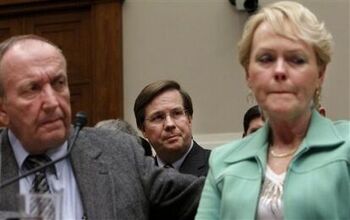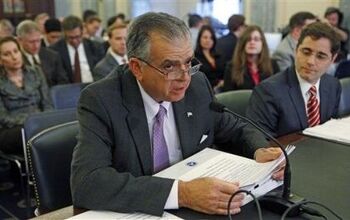The Toyota Testimony, Day One: A Comedy In Three Parts: Act One: The Expert Evidence
It’s been nearly a year since the automotive industry has been treated to a must-watch DC hearing. The last time around, when the executives of America’s automakers went begging to congress for multi-billion dollar bailouts, hearings were heated and combative. Though liberally sprinkled with irony and comedic ignorance, those hearings were, at their heart, a traditional partisan stand-off. But bailouts are also a relatively cut-and-dried topic: you either support them for solid political reasons, or you oppose them for equally solid, equally political reasons. But faced with a national bogeyman of legendary mystery, the lurking terror of unintended acceleration, congress’s task was more complicated than the bailout’s do-we-or-don’t-we dilemma. Tasked with uncovering the truth behind a complex technical problem, is it any wonder that yesterday’s hearings before the House Energy Committee took a turn for the strangely hilarious? [Editor’s note: full prepared statements from all witnesses are available in PDF format here full video of all of yesterday’s testimony is available at CSPAN]
Watching congress tackle the problem of out-of-control cars is something like watching a panel of tenured literature professors struggle to open a jar of pickles: the problem isn’t necessarily that the individuals involved aren’t intelligent, it’s that they are stunningly ill-prepared for the task. Not only are most representatives not trained to understand the complexities of automotive systems, they’re also constitutionally incapable of contemplating the possibility that as one of America’s best-selling brands, Toyota likely sells a lot of cars to stupid people. The possibility that even a small percentage of the unintended acceleration cases might have been caused by (or at least were not averted because of) human error was, at best, only obliquely hinted at for the simple reason that congressional hearings always require a satisfyingly sinister scapegoat. Just as nobody blamed individuals for voluntarily taking on risky mortgages during the subprime lending crisis hearings, there was little doubt that anybody other than Toyota and the NHTSA would be blamed for the deaths resulting from sudden unintended acceleration. Therefore, congress’s task was to understand the problem in such a way that consciously kept attention on these two, admittedly imperfect organizations.
Luckily for congress, there is no shortage of “expert witnesses” willing to place all of the blame on Toyota and the NHTSA, and the first act of yesterday’s hearings opened with testimony from a select few of these witnesses. These witnesses, Sean Kane of Safety Research & Strategies, David Gilbert of Southern Illinois University, and unintended acceleration victim Rhonda Smith of Sevierville, Tenn, were called to fill in the obvious gaps in the committees knowledge of the complexities of sudden unintended acceleration. Unfortunately, these three witnesses probably confused the committee as much as they did enlighten it.
Ms Smith was the first witness to place her statement on the record, and she delivered her testimony with the kind of folksy gravitas that makes congress weak in the knees. Better yet, her story was so outrageously inexplicable that congress was faced with only two options: take her story at face value or suggest (as Toyota has) that Ms Smith’s story can not be fully explained without relying on a belief in divine (or diabolical) intervention. Ms Smith and her husband certainly didn’t deny the role of the supernatural in her experience, but because the hearing’s pre-determined villains had implied that the lack of rational explanations for her incident placed a certain amount of responsibility on her shoulders, repetition of such suggestions would not have served the hearing’s purpose.
In providing an inexplicable example of unintended acceleration, the Smith’s testimony set the tone for the rest of the hearing. No other witnesses were called to provide supporting evidence of the apparent simultaneous brake, engine and transmission control failure that Ms Smith claims to have experienced. As a result, the hearings proceeded with congress’s limited engineering knowledge enhanced only by a single scenario in which an untrained witness described a vehicle that was clearly possessed by some mysterious, malignant force. Which, as it turns out, suited the final two expert witnesses just fine.
Sean Kane, an analyst for the independent Safety Research & Strategies, was not able to offer any better explanation for Toyota’s unintended acceleration problems than the Smiths. First blaming Toyota for failing to recognize the problem of pedal entrapment, Kane then went on to claim that pedal entrapment couldn’t explain most UA complaints on the record. This strategy added to Toyota’s halo of shame while consciously failing to present any rational explanation for what might be causing the incidents beyond the lurking, sci-fi menace of electronics gone mysteriously wrong. Kane’s expert backup, Dr. Gilbert, was no more helpful, proving only that he was able to cause UA in Toyotas without triggering an error code.
After one first-hand account and two expert witnesses, the committee actually knew less than they had before the hearing began. Worse still, the evidence they did hear was orchestrated in such a way as to leverage this ignorance: the Smiths proved only that no driver should be held accountable for UA in a Toyota because shifting into neutral and even reverse at 100 mph (let alone using brakes and emergency brakes) hadn’t stopped the car (until it did), while Kane proved that mysterious Toyota-exclusive electronic problems are widespread, and Gilbert proved that they are untraceable.
Needless to say, this was no coincidence. As these three witnesses fielded confused questions from the committee some key facts arose about their testimony: first, Kane’s report was sponsored by five law firms, each of which have suits pending against Toyota and second, that Kane had paid Gilbert for his analysis. If these facts (and Kane and Gilbert’s huffy reactions to them) altered the opinion of any committee members, it didn’t matter. These were the only witnesses called, and when they were finished, the time had come for congress to grill the bad guys: Toyota’s Jim Lentz and and Secretary of Transportation Ray LaHood.
More by Edward Niedermeyer
Latest Car Reviews
Read moreLatest Product Reviews
Read moreRecent Comments
- Redapple2 Love the wheels
- Redapple2 Good luck to them. They used to make great cars. 510. 240Z, Sentra SE-R. Maxima. Frontier.
- Joe65688619 Under Ghosn they went through the same short-term bottom-line thinking that GM did in the 80s/90s, and they have not recovered say, to their heyday in the 50s and 60s in terms of market share and innovation. Poor design decisions (a CVT in their front-wheel drive "4-Door Sports Car", model overlap in a poorly performing segment (they never needed the Altima AND the Maxima...what they needed was one vehicle with different drivetrain, including hybrid, to compete with the Accord/Camry, and decontenting their vehicles: My 2012 QX56 (I know, not a Nissan, but the same holds for the Armada) had power rear windows in the cargo area that could vent, a glass hatch on the back door that could be opened separate from the whole liftgate (in such a tall vehicle, kinda essential if you have it in a garage and want to load the trunk without having to open the garage door to make room for the lift gate), a nice driver's side folding armrest, and a few other quality-of-life details absent from my 2018 QX80. In a competitive market this attention to detai is can be the differentiator that sell cars. Now they are caught in the middle of the market, competing more with Hyundai and Kia and selling discounted vehicles near the same price points, but losing money on them. They invested also invested a lot in niche platforms. The Leaf was one of the first full EVs, but never really evolved. They misjudged the market - luxury EVs are selling, small budget models not so much. Variable compression engines offering little in terms of real-world power or tech, let a lot of complexity that is leading to higher failure rates. Aside from the Z and GT-R (low volume models), not much forced induction (whether your a fan or not, look at what Honda did with the CR-V and Acura RDX - same chassis, slap a turbo on it, make it nicer inside, and now you can sell it as a semi-premium brand with higher markup). That said, I do believe they retain the technical and engineering capability to do far better. About time management realized they need to make smarter investments and understand their markets better.
- Kwik_Shift_Pro4X Off-road fluff on vehicles that should not be off road needs to die.
- Kwik_Shift_Pro4X Saw this posted on social media; “Just bought a 2023 Tundra with the 14" screen. Let my son borrow it for the afternoon, he connected his phone to listen to his iTunes.The next day my insurance company raised my rates and added my son to my policy. The email said that a private company showed that my son drove the vehicle. He already had his own vehicle that he was insuring.My insurance company demanded he give all his insurance info and some private info for proof. He declined for privacy reasons and my insurance cancelled my policy.These new vehicles with their tech are on condition that we give up our privacy to enter their world. It's not worth it people.”


































Comments
Join the conversation
My opinion, she is a lier. She sold the car after it tried to kill her. Obviously without warning the new buyers. The car has had 27,000 trouble free miles put on it since. Either she is lying or she is a heartless wench who sold a life threatening car to someone else. She looks nice to me, so I am going with lier.
Good joke calling Safety Research & Strategies "independent." You should know better, as it's difficult to conceive of an outfit more completely in the pockets of the trial lobby that SR&S. Here's a WSJ article that lays out the sordid story: http://tinyurl.com/y9bqawx .